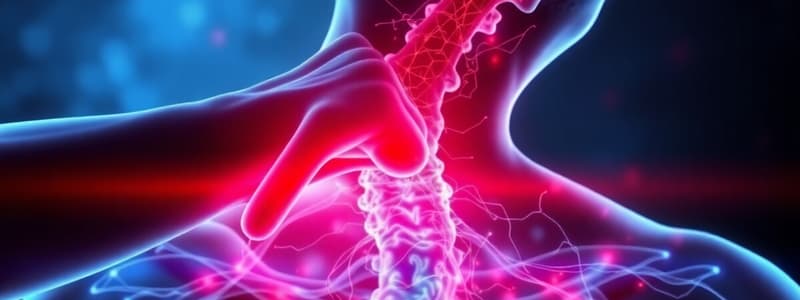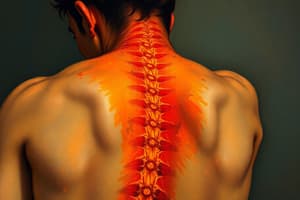Podcast
Questions and Answers
What term describes pain due to a stimulus that does not normally produce pain?
What term describes pain due to a stimulus that does not normally produce pain?
- Neuropathic pain
- Allodynia (correct)
- Hyperalgesia
- Hyperaesthesia
What type of pain results from nerve injury, as seen in conditions such as diabetes mellitus and HIV infection?
What type of pain results from nerve injury, as seen in conditions such as diabetes mellitus and HIV infection?
- Dysfunctional pain
- Inflammatory pain
- Neuropathic pain (correct)
- Physiologic pain
Which category of pain is characterized by increased sensitivity to stimulation excluding special senses?
Which category of pain is characterized by increased sensitivity to stimulation excluding special senses?
- Inflammatory pain
- Allodynia
- Hyperaesthesia (correct)
- Dysfunctional pain
Which mechanism initiates the generation of action potentials in pain transmission?
Which mechanism initiates the generation of action potentials in pain transmission?
In what type of pain do patients experience severe pain in the absence of noxious stimuli, such as in fibromyalgia?
In what type of pain do patients experience severe pain in the absence of noxious stimuli, such as in fibromyalgia?
Which type of pain is specifically linked to tissue injury and inflammation, causing heightened pain from noxious stimuli?
Which type of pain is specifically linked to tissue injury and inflammation, causing heightened pain from noxious stimuli?
What is the role of N-type voltage-gated calcium channels in pain transmission?
What is the role of N-type voltage-gated calcium channels in pain transmission?
Which of the following NSAIDs exhibits irreversible inactivation of COX-1?
Which of the following NSAIDs exhibits irreversible inactivation of COX-1?
What is a significant adverse effect associated with selective COX-2 inhibitors?
What is a significant adverse effect associated with selective COX-2 inhibitors?
Which medication is primarily an analgesic and antipyretic but has little anti-inflammatory effect?
Which medication is primarily an analgesic and antipyretic but has little anti-inflammatory effect?
Which of the following NSAIDs is known for having a higher potency and longer half-life compared to Ibuprofen?
Which of the following NSAIDs is known for having a higher potency and longer half-life compared to Ibuprofen?
What is one of the risks associated with non-selective COX inhibitors?
What is one of the risks associated with non-selective COX inhibitors?
Which of the following statements is accurate regarding Salicylates such as Aspirin?
Which of the following statements is accurate regarding Salicylates such as Aspirin?
What is a primary reason for prescribing Ketorolac?
What is a primary reason for prescribing Ketorolac?
Which medication is least likely to cause GI adverse effects compared to others?
Which medication is least likely to cause GI adverse effects compared to others?
What is a major concern associated with the overdose of Acetaminophen?
What is a major concern associated with the overdose of Acetaminophen?
Which statement accurately describes the role of tryptans in migraine treatment?
Which statement accurately describes the role of tryptans in migraine treatment?
What is a common characteristic of the medications used for acute migraine attacks?
What is a common characteristic of the medications used for acute migraine attacks?
Which prophylactic treatment is NOT indicated for reducing migraine occurrence?
Which prophylactic treatment is NOT indicated for reducing migraine occurrence?
Which of the following best describes the half-life comparison between naloxone and morphine?
Which of the following best describes the half-life comparison between naloxone and morphine?
What therapeutic approach is commonly recommended for managing pain in clinical settings, according to recent practices?
What therapeutic approach is commonly recommended for managing pain in clinical settings, according to recent practices?
What distinguishes NSAIDs from acetaminophen in terms of their mechanism of action?
What distinguishes NSAIDs from acetaminophen in terms of their mechanism of action?
What role do inflammatory cytokines play in neuropathic pain?
What role do inflammatory cytokines play in neuropathic pain?
Which of the following antiepileptics is NOT typically used to manage neuropathic pain?
Which of the following antiepileptics is NOT typically used to manage neuropathic pain?
How do TCAs such as amitriptyline affect pain management?
How do TCAs such as amitriptyline affect pain management?
What is the primary mechanism by which gabapentin exerts its effects on chronic pain?
What is the primary mechanism by which gabapentin exerts its effects on chronic pain?
Which treatment is indicated for both neuropathic pain and fibromyalgia?
Which treatment is indicated for both neuropathic pain and fibromyalgia?
What is a key characteristic of neuropathic pain following nerve injury?
What is a key characteristic of neuropathic pain following nerve injury?
Which statement regarding opioids and NSAIDs combined treatment is true?
Which statement regarding opioids and NSAIDs combined treatment is true?
What negative aspect contributes to neuropathic pain through the loss of support in nerve recovery?
What negative aspect contributes to neuropathic pain through the loss of support in nerve recovery?
What distinguishes dual NE/serotonin reuptake inhibitors from traditional antidepressants in pain management?
What distinguishes dual NE/serotonin reuptake inhibitors from traditional antidepressants in pain management?
What is the primary mechanism of action of μ-opioid receptor agonists in the spinal cord?
What is the primary mechanism of action of μ-opioid receptor agonists in the spinal cord?
Which drug is specifically used to treat trigeminal neuralgia and acts by blocking Na+ channels?
Which drug is specifically used to treat trigeminal neuralgia and acts by blocking Na+ channels?
What are common adverse effects associated with opioids?
What are common adverse effects associated with opioids?
Which medication has a faster onset and more predictable bioavailability than gabapentin?
Which medication has a faster onset and more predictable bioavailability than gabapentin?
Which drug would likely cause fewer dose-related CNS adverse effects compared to gabapentin?
Which drug would likely cause fewer dose-related CNS adverse effects compared to gabapentin?
What is a characteristic of full agonists in the opioid category?
What is a characteristic of full agonists in the opioid category?
What distinguishes oxcarbazepine from carbamazepine?
What distinguishes oxcarbazepine from carbamazepine?
Which option correctly describes the CNS effects of opioids?
Which option correctly describes the CNS effects of opioids?
Which of the following is NOT a typical use of pregabalin?
Which of the following is NOT a typical use of pregabalin?
Flashcards
What is pain?
What is pain?
An unpleasant sensory and emotional experience associated with actual or potential tissue damage.
Hyperaesthesia
Hyperaesthesia
Increased sensitivity to stimulation, excluding the special senses.
Hyperalgesia
Hyperalgesia
Increased pain in response to a noxious stimulus.
Allodynia
Allodynia
Signup and view all the flashcards
Physiologic pain
Physiologic pain
Signup and view all the flashcards
Inflammatory pain
Inflammatory pain
Signup and view all the flashcards
Neuropathic pain
Neuropathic pain
Signup and view all the flashcards
NSAIDS (Non-Steroidal Anti-Inflammatory Drugs)
NSAIDS (Non-Steroidal Anti-Inflammatory Drugs)
Signup and view all the flashcards
Aspirin (Acetylsalicylic acid)
Aspirin (Acetylsalicylic acid)
Signup and view all the flashcards
COX-1 and COX-2
COX-1 and COX-2
Signup and view all the flashcards
Selective COX-2 Inhibitors (Celecoxib)
Selective COX-2 Inhibitors (Celecoxib)
Signup and view all the flashcards
Ibuprofen
Ibuprofen
Signup and view all the flashcards
Naproxen
Naproxen
Signup and view all the flashcards
Phenylacetic acid derivatives (Diclofenac and Ketorolac)
Phenylacetic acid derivatives (Diclofenac and Ketorolac)
Signup and view all the flashcards
Acetaminophen (Paracetamol)
Acetaminophen (Paracetamol)
Signup and view all the flashcards
Low Therapeutic Index of Acetaminophen
Low Therapeutic Index of Acetaminophen
Signup and view all the flashcards
What is a migraine headache?
What is a migraine headache?
Signup and view all the flashcards
How do triptans work in treating migraines?
How do triptans work in treating migraines?
Signup and view all the flashcards
What is the purpose of migraine prophylaxis medications?
What is the purpose of migraine prophylaxis medications?
Signup and view all the flashcards
What are some common medications used for migraine prophylaxis?
What are some common medications used for migraine prophylaxis?
Signup and view all the flashcards
What are acute migraine medications used for?
What are acute migraine medications used for?
Signup and view all the flashcards
What is Pregabalin?
What is Pregabalin?
Signup and view all the flashcards
What is Carbamazepine?
What is Carbamazepine?
Signup and view all the flashcards
What is Oxcarbazepine?
What is Oxcarbazepine?
Signup and view all the flashcards
What are Opioid Receptor Agonists?
What are Opioid Receptor Agonists?
Signup and view all the flashcards
How do µ-opioid receptor agonists work in the spinal cord?
How do µ-opioid receptor agonists work in the spinal cord?
Signup and view all the flashcards
What are the cardiovascular adverse effects of opioids?
What are the cardiovascular adverse effects of opioids?
Signup and view all the flashcards
What are the respiratory adverse effects of opioids?
What are the respiratory adverse effects of opioids?
Signup and view all the flashcards
What is Morphine?
What is Morphine?
Signup and view all the flashcards
What is Meperidine?
What is Meperidine?
Signup and view all the flashcards
What is Methadone?
What is Methadone?
Signup and view all the flashcards
How do NSAIDs and COX-2 inhibitors work differently from acetaminophen?
How do NSAIDs and COX-2 inhibitors work differently from acetaminophen?
Signup and view all the flashcards
What causes neuropathic pain?
What causes neuropathic pain?
Signup and view all the flashcards
How do tricyclic antidepressants (TCAs) work for neuropathic pain?
How do tricyclic antidepressants (TCAs) work for neuropathic pain?
Signup and view all the flashcards
What are dual norepinephrine/serotonin reuptake inhibitors and how do they help with pain?
What are dual norepinephrine/serotonin reuptake inhibitors and how do they help with pain?
Signup and view all the flashcards
Why are antidepressants used in chronic pain management?
Why are antidepressants used in chronic pain management?
Signup and view all the flashcards
Why are antiepileptic drugs used for pain?
Why are antiepileptic drugs used for pain?
Signup and view all the flashcards
How does gabapentin work for pain?
How does gabapentin work for pain?
Signup and view all the flashcards
What's special about gabapentin's chemical structure and how it works?
What's special about gabapentin's chemical structure and how it works?
Signup and view all the flashcards
Compare TCAs and dual reuptake inhibitors for neuropathic pain.
Compare TCAs and dual reuptake inhibitors for neuropathic pain.
Signup and view all the flashcards
Compare gabapentin, pregabalin, and carbamazepine for pain management.
Compare gabapentin, pregabalin, and carbamazepine for pain management.
Signup and view all the flashcards
Study Notes
Pharmacology of Analgesia
- Analgesia is the unpleasant sensory and emotional experience associated with actual or potential tissue damage
- Types of pain: Physiologic (intense/noxious stimulus), Inflammatory (tissue injury/inflammation causing heightened sensitivity, e.g., rheumatoid arthritis), Neuropathic (nerve injury, e.g., amputation or diabetes), and Dysfunctional (pain without noxious stimuli, e.g., tension-type headache or fibromyalgia).
Mechanisms of Pain
- Transduction of intense/noxious stimuli depolarizes peripheral terminals of high-threshold primary sensory neurons (nociceptors), requiring a strong stimulus.
- Action potentials are conducted to the CNS via peripheral nerves and dorsal roots, synapsing on neurons in the dorsal horn of the spinal cord.
- Secondary projection neurons transmit information to the brainstem and thalamus, then relay signals to the cortex, hypothalamus, and limbic system.
- Transmission is regulated by inhibitory and excitatory interneurons.
Neurotransmission in the Spinal Cord Dorsal Horn
- Neurotransmission in the dorsal horn relays signals to CNS neurons that signal to the brain, part of a circuit also receiving descending modulatory control.
Descending and Local Inhibitory Regulation in the Spinal Cord
- Spinal cord synaptic transmission is regulated by local inhibitory interneurons and descending projections from the brainstem.
- These systems limit incoming sensory information, a crucial site for pharmacologic intervention.
- Key inhibitory neurotransmitters include opioid peptides, norepinephrine, serotonin (5-HT), glycine, and GABA.
Pain Management
- Pain treatment depends on the type (nociceptive or neuropathic) of pain.
- Nociceptive pain (e.g., mild to moderate arthritic pain) can be managed with non-opioid analgesics (like NSAIDs).
- Chronic inflammatory pain can be treated with NSAIDs, DMARDs , TNF-α inhibitors, immunosuppressants, and monoclonal antibodies.
- Neuropathic pain can be treated with TCAs, serotonin-norepinephrine reuptake inhibitors,and anticonvulsants.
- Severe acute pain and chronic pain may include opioid use.
Non-Steroidal Anti-Inflammatory Drugs (NSAIDs)
- NSAIDs inhibit the activity of cyclooxygenase enzymes (COX-1 and COX-2) required for prostaglandin production.
- Major classes: Salicylates (e.g., aspirin), Propionic acid derivatives (e.g., ibuprofen, naproxen), Phenylacetic acid derivatives (e.g., diclofenac, ketorolac), and Selective COX-2 inhibitors (e.g., celecoxib).
- NSAIDs affect pain pathways by reducing prostaglandin synthesis, decreasing leukocyte recruitment, and preventing prostaglandin generation in the spinal cord.
- Adverse effects of non-selective COX inhibitors can include gastric mucosa and kidney injury.
Analgesic-Antipyretic Acetaminophen (Paracetamol)
- Low anti-inflammatory effects; primarily reduces prostaglandin synthesis in the CNS.
- Frequently combined with weak opioids for moderate pain.
- Major concern is low therapeutic index; overdose can cause liver failure.
- Works by penetrating the blood-brain barrier, blocking COX-3 in the brain, blocking PGE formation/release, and inhibiting pyrogens on heat-regulating centers of the brain, resulting in antipyretic effect.
NSAIDs and COX-2 Inhibitors
- NSAIDs and COX-2 inhibitors act centrally and peripherally.
- Celecoxib is a prominent COX-2 inhibitor and still in use, minimizing GI, renal, and hematological adverse effects.
Neuropathic Pain
- Nerve injury involves both functional and structural alterations in the nervous system.
- Peripheral and central alterations, including inflammation and loss of nerve growth factors, contribute.
- Positive signals such as inflammatory cytokines (by macrophages and Schwann cells); negative signals like loss of peripheral support.
- Sodium channel expression pattern changes in injured primary sensory neurons.
Treatment for Neuropathic Pain
- Treatment options for neuropathic pain include tricyclic antidepressants (TCAs), dual NE/serotonin reuptake inhibitors, and antiepileptic drugs (AEDs).
Analgesic Use of Antidepressants
- TCAs like amitriptyline and dual NE/serotonin reuptake inhibitors like venlafaxine are used as adjuvants in chronic pain management, to increase antinociceptive noradrenergic and serotonergic projections to the spinal cord.
Analgesic Use of Antiepileptics
- Drugs like gabapentin, pregabalin, and carbamazepine are often used to reduce neuronal excitability, treating chronic pain conditions.
Gabapentin, Pregabalin and Carbamazepine (AEDs)
- Gabapentin and pregabalin are structural GABA analogs with no effect on GABA receptors but bind to a2δ subunit of voltage-dependent calcium channels.
- Gabapentin is useful in trigeminal neuralgia, diabetic neuropathy, and post-op pain.
- Pregabalin is similar but has faster onset and more predictable bioavaibility.
- Carbamazepine is a sodium channel blocker and oxcarbazepine is its derivative, useful in trigeminal neuralgia.
Severe Acute Pain or Chronic Pain
- Management could utilize opioids.
- Opioid receptor agonists are primary class for moderate to severe acute pain.
Opioid Receptors and Agonists
- Opioids (e.g., Morphine, Hydromorphone, Codeine, Oxycodone, Methadone, Fentanyl, Meperidine).
- Partial and Mixed Opioid Agonists (e.g., Buprenorphine, Butorphanol, Nalbuphine).
- Opioid Receptor Antagonists (e.g., Naloxone, Naltrexone).
Opioid Receptor Agonist Mechanism
- Activation of presynaptic and postsynaptic μ-opioid receptors by descending/local circuit inhibitory neurons inhibits central relaying of nociceptive stimuli.
- In the presynaptic terminal, decrease in calcium influx; postsynaptic increase in K+ conductance, decreasing the postsynaptic response to excitatory neurotransmission.
Adverse Effects of Opioids
- Cardiovascular (decreased sympathetic tone → hypotension, bradycardia); respiratory (suppression, apnea); gastrointestinal (constipation, nausea, vomiting); central nervous system (sedation, dizziness, confusion); and addiction potential.
Migraine Therapy
- Migraine is a headache disorder characterized by headache lasting up to 3 days typically accompanied by light and sound avoidance, and nausea. In some cases, aura, transient neurological symptoms are associated with the migraine.
- Tryptan serotonin receptor agonists (e.g., sumatriptan) act on 5HT-1B/1D receptors, reducing vascular and nociceptive transmission.
- Other treatments with acute attacks include NSAIDs, opioids, caffeine, and antiemetics.
- Prophylactic drugs may include β-blockers, valproic acid, serotonin antagonists, Ca2+ channel blockers, or TCAs.
Summary
- Polypharmacy often used for effective pain management.
- Analgesic targets continue to be identified for potential new therapies.
- Effective pain management extends beyond pharmacology with physical therapy, etc., and, at times, surgery, needed to address multi-factorial issues.
Studying That Suits You
Use AI to generate personalized quizzes and flashcards to suit your learning preferences.




